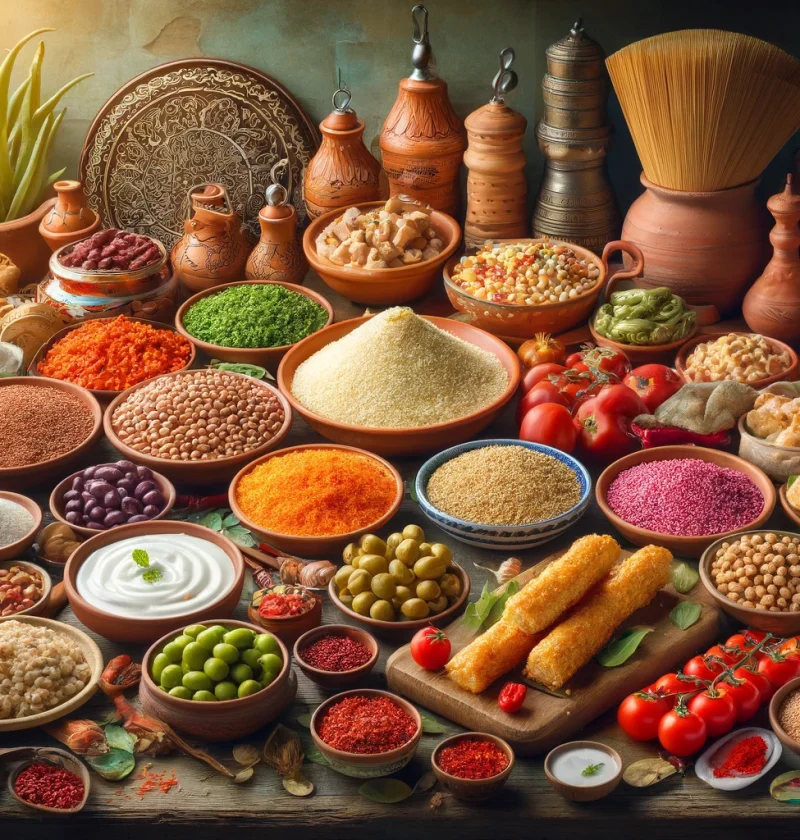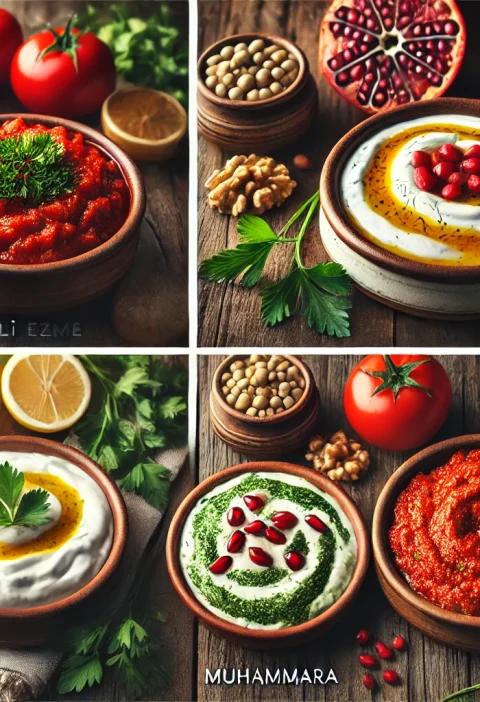Key Ingredients in Traditional Turkish Dishes
Introduction
Turkish cuisine is a vibrant and diverse culinary tradition that has captivated food lovers around the world. With its rich history and unique flavors, Turkish food offers a tantalizing array of dishes that range from hearty breakfasts to delicious desserts. In this blog post, we will explore the essential ingredients that form the backbone of traditional Turkish dishes, providing insights into the spices, meats, and vegetables that make this cuisine so special.
The Rich Tapestry of Turkish Cuisine
Turkish cuisine is a harmonious blend of various culinary traditions, influenced by the nomadic Turkic peoples, as well as Indian, Islamic, Mediterranean, and Balkan cuisines. The result is a rich tapestry of flavors and textures that are both unique and universally appealing. Whether you’re a seasoned cook or a curious foodie, understanding the key ingredients in Turkish cuisine is the first step to mastering its delicious dishes.
Key Ingredients of Turkish Cuisine
1. Bulgur
Bulgur is a staple in Turkish cuisine, often used as a side dish or filling. This golden grain is easy to prepare and versatile, making it a healthier alternative to pasta and rice. Popular dishes featuring bulgur include kisir (bulgur salad) and various pilafs.
2. Legumes
Legumes, such as kidney beans, chickpeas, and red lentils, are essential in Turkish cooking. They are used in a variety of dishes, from meze (appetizers) to hearty stews. One of the most famous dishes is kuru fasulye (white bean stew), a national favorite.
3. Salça
Salça, a tomato or paprika paste, is a cornerstone of Turkish cooking. Unlike regular tomato paste, salça is elaborately cooked and seasoned with various spices, giving it a unique flavor that enhances many dishes.
4. Olives and Olive Oil
Olives and olive oil are integral to Turkish cuisine. Pickled olives are a common feature on breakfast tables, while olive oil is used in cooking and dressing salads. The rich, fruity flavor of Turkish olives adds depth to many dishes.
5. Yufka
Yufka is a thin, unleavened dough used to make popular Turkish pastries like baklava, börek, and gözleme. This versatile dough can be filled with a variety of ingredients, from sweet nuts to savory cheeses and spinach.
6. Yogurt
Yogurt is a fundamental ingredient in Turkish cuisine, used in both savory and sweet dishes. It is also the base for ayran, a refreshing yogurt-based drink. The creamy texture and tangy flavor of Turkish yogurt make it a versatile addition to many recipes.
7. Tomatoes
Tomatoes are ubiquitous in Turkish cooking, known for their intense flavor and vibrant color. They are used in salads, stews, and sauces, adding a fresh and tangy element to dishes.
8. Pul Biber
Pul biber, or Turkish chili flakes, are a popular spice that adds heat and depth to many dishes. These chili flakes are often sprinkled over kebabs, stews, and even salads, providing a spicy kick that is characteristic of Turkish cuisine.
Cooking Techniques in Turkish Cuisine
Grilling on a Mangal
Grilling over a mangal, a type of charcoal grill, is a beloved cooking method in Turkey. This technique is essential for preparing various types of kebabs, including the famous Adana and Urfa kebabs. The high heat of the charcoal imparts a smoky flavor that is highly prized in Turkish culinary traditions.
Baking in Stone Ovens
Turkish pide, lahmacun, and some types of börek are traditionally cooked in stone ovens. These ovens provide a high, consistent heat that cooks dough quickly and evenly, giving it a distinctive crisp texture and rich flavor.
Simmering in Clay Pots
Slow cooking in clay pots, or güveç, is another traditional technique used throughout Turkey. This method allows for slow, even cooking that enhances the natural flavors of the ingredients. Dishes like kleftiko (slow-cooked lamb) and various vegetable stews are often prepared this way.
The Importance of Fresh Herbs and Spices
Parsley and Mint
Fresh herbs like parsley and mint are commonly used in Turkish cuisine. They add a burst of freshness and are often used as garnishes or in salads like tabbouleh.
Sumac
Sumac, a tangy spice, is used to add a lemony flavor to dishes. It’s often sprinkled over salads and grilled meats, enhancing their flavors with its unique taste.
Cumin
Cumin is a warm, earthy spice that’s frequently used in Turkish cooking. It’s a key ingredient in dishes like köfte (meatballs) and various stews.
Dairy Products Beyond Yogurt
Cheese Varieties
Turkish cuisine features a variety of cheeses, such as beyaz peynir (white cheese), kaşar (a semi-hard cheese), and lor (a type of ricotta). These cheeses are used in everything from breakfast spreads to baked goods.
Kaymak
Kaymak, a clotted cream, is often served with honey and bread for breakfast. Its rich, creamy texture makes it a luxurious addition to any meal.
Bread: The Heart of Turkish Meals
Pide
Pide is a soft, flatbread that’s often topped with ingredients like cheese, meat, or vegetables and baked in a stone oven. It’s a staple at many Turkish meals.
Simit
Simit is a sesame-encrusted bread ring that’s a popular street food in Turkey. It’s often enjoyed with tea as a light snack.
Meat and Seafood
Lamb
Lamb is the most commonly used meat in Turkish cuisine. It’s featured in dishes like kebabs, stews, and stuffed vegetables.
Fish
Turkey’s coastal regions provide an abundance of fresh fish. Grilled fish, fish stews, and seafood meze are popular dishes in these areas.
Vegetables: Fresh and Flavorful
Eggplant
Eggplant is a versatile vegetable in Turkish cuisine, used in dishes like imam bayildi (stuffed eggplant) and karnıyarık (eggplant stuffed with meat).
Peppers
Both sweet and hot peppers are used in Turkish cooking. They add color and flavor to dishes like dolma (stuffed peppers) and menemen (a scrambled egg dish with peppers and tomatoes).
Nuts and Dried Fruits
Pistachios and Almonds
Pistachios and almonds are commonly used in Turkish desserts, such as baklava and Turkish delight. They add a delightful crunch and rich flavor.
Apricots and Figs
Dried apricots and figs are often used in sweet and savory dishes. They add natural sweetness and a chewy texture to recipes.
Turkish Sweets and Desserts
Baklava
Baklava is a rich, sweet pastry made of layers of yufka dough, filled with nuts, and sweetened with syrup or honey. It’s a beloved dessert in Turkey.
Turkish Delight
Turkish delight, or lokum, is a gelatinous candy that’s often flavored with rosewater, lemon, or pistachio. It’s a popular treat and a common gift.
Beverages
Turkish Tea
Turkish tea is a strong, black tea served in small, tulip-shaped glasses. It’s an essential part of Turkish hospitality and daily life.
Turkish Coffee
Turkish coffee is a strong, unfiltered coffee served with a layer of grounds at the bottom. It’s often enjoyed with a piece of Turkish delight.
Conclusion
Understanding the key ingredients and cooking techniques of Turkish cuisine is essential for anyone looking to explore this rich culinary tradition. From the versatile bulgur to the tangy yogurt, each ingredient plays a crucial role in creating the unique flavors that define Turkish dishes. Whether you’re preparing a simple meze or a complex stew, these ingredients will help you bring the authentic taste of Turkey to your kitchen.



